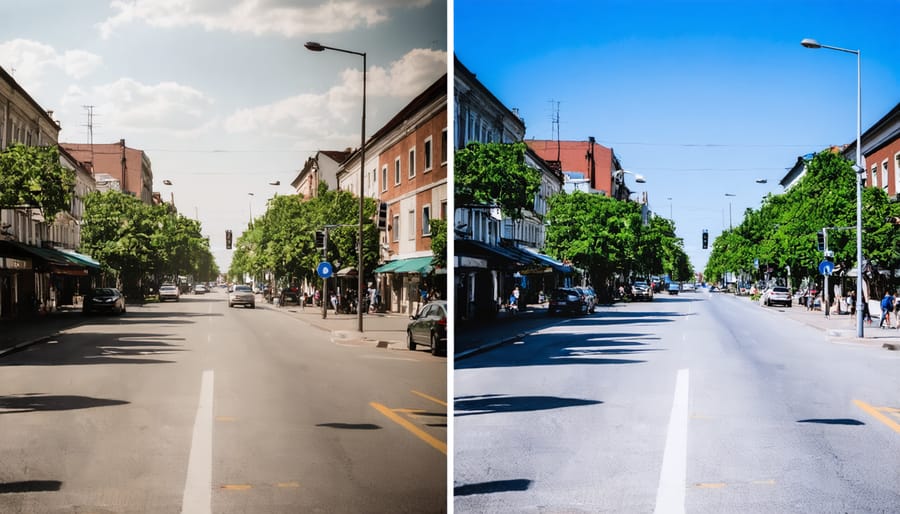Modern mobility planning transcends traditional transportation infrastructure, demanding a comprehensive approach that integrates smart mobility solutions with sustainable urban development. The convergence of autonomous vehicles, shared transportation systems, and data-driven infrastructure has fundamentally transformed how cities approach movement patterns and accessibility.
Urban planners and construction professionals must now consider mobility as a complex ecosystem where pedestrian flows, vehicular traffic, and public transportation intersect with emerging technologies and environmental imperatives. This integrated approach requires sophisticated modeling tools, real-time data analytics, and adaptive infrastructure solutions that can evolve with changing urban needs.
The stakes are unprecedented: by 2050, 68% of the global population will reside in urban areas, making efficient mobility planning crucial for economic vitality, environmental sustainability, and quality of life. Success demands collaboration between construction professionals, urban planners, technology providers, and policy makers to create transportation networks that are not just efficient, but also resilient, sustainable, and equitable.
This paradigm shift in mobility planning represents both a challenge and an opportunity for construction professionals to reshape urban landscapes through innovative infrastructure solutions and forward-thinking design strategies.
The Evolution of Urban Mobility Planning
From Car-Centric to People-First Design
The transition from car-centric to people-first design represents a fundamental shift in modern urban planning approaches. This evolution prioritizes pedestrian accessibility, public transportation integration, and mixed-use development over traditional automobile-focused infrastructure.
Recent data indicates that cities implementing people-first design principles experience up to 30% reduction in vehicle emissions and a 40% increase in pedestrian activity. These transformations often begin with the conversion of parking spaces into public plazas, the introduction of dedicated bicycle lanes, and the expansion of sidewalk infrastructure.
Key elements of this paradigm shift include traffic calming measures, transit-oriented development (TOD), and the implementation of complete streets policies. Cities like Copenhagen and Amsterdam demonstrate the long-term benefits of this approach, showing increased economic activity in pedestrianized zones and improved public health outcomes.
Construction professionals must now consider multimodal transportation requirements in their designs, incorporating features such as protected bike lanes, enhanced pedestrian crossings, and seamless connections to public transit hubs. This integrated approach ensures that new developments contribute to more sustainable, livable urban environments.

Integration of Smart Technologies
Smart technologies have revolutionized mobility planning through the integration of data-driven solutions and digital infrastructure. Real-time traffic management systems, powered by IoT sensors and artificial intelligence, enable dynamic responses to changing traffic patterns and urban mobility demands. These systems collect and analyze vast amounts of data from various sources, including connected vehicles, public transportation networks, and pedestrian movement patterns.
Advanced mobility platforms now incorporate predictive analytics to forecast traffic conditions and optimize route planning. Smart traffic signals adapt to real-time conditions, while mobile applications provide users with multimodal transportation options and live updates. The implementation of smart parking systems reduces congestion by guiding drivers directly to available spaces, while integrated payment systems streamline the user experience across different transport modes.
Digital twins of transportation networks allow planners to simulate and test various scenarios before implementation, reducing risks and optimizing resources. These virtual models help identify potential bottlenecks and evaluate the impact of proposed changes to mobility infrastructure. The integration of 5G technology further enhances these capabilities by enabling faster data transmission and more reliable connectivity between mobility systems and users.
Key Components of Effective Mobility Planning
Multi-Modal Transportation Networks
Multi-modal transportation networks represent the cornerstone of effective mobility planning, integrating various transport modes to create seamless connectivity across urban landscapes. These networks combine traditional infrastructure with emerging mobility solutions, including public transit systems, pedestrian pathways, cycling infrastructure, and vehicular roads.
The success of multi-modal networks hinges on strategic infrastructure integration. Transit hubs serve as critical connection points, requiring careful design to facilitate smooth transfers between different transportation modes. These facilities must incorporate essential elements such as secure bicycle storage, passenger waiting areas, and clear wayfinding systems.
Infrastructure requirements vary significantly across different transport modes. Light rail systems demand dedicated rights-of-way and electrification infrastructure, while bus rapid transit requires specialized lanes and smart signaling systems. Pedestrian and cycling networks necessitate protected pathways, crossing facilities, and appropriate lighting for safety.
Digital integration plays an increasingly vital role, with smart transportation management systems coordinating different modes in real-time. These systems optimize route planning, reduce transfer times, and enhance overall network efficiency. Modern mobility hubs now incorporate charging infrastructure for electric vehicles and micro-mobility options, future-proofing transportation networks.
Implementation success depends on comprehensive planning that considers capacity requirements, accessibility standards, and environmental impact. Recent case studies demonstrate that cities achieving optimal modal integration experience reduced congestion, improved air quality, and enhanced urban livability.

Data-Driven Decision Making
In today’s rapidly evolving urban landscape, data analytics has become the cornerstone of effective mobility planning. Modern transportation systems generate vast amounts of information through sensors, GPS tracking, and IoT devices, enabling planners to make informed decisions based on empirical evidence rather than assumptions.
Real-time data collection systems monitor traffic patterns, pedestrian flows, and public transit utilization, providing invaluable insights for optimization. These analytics help identify peak usage periods, bottlenecks, and underserved areas, allowing planners to implement targeted improvements and digital transportation solutions that address specific community needs.
Advanced predictive modeling tools now enable planners to simulate various scenarios before implementation, reducing the risk of costly mistakes. These models incorporate multiple variables, including population growth projections, economic indicators, and environmental factors, to forecast future mobility demands and evaluate potential solutions.
The integration of big data analytics has also revolutionized demand-responsive planning. Transportation authorities can now adjust service levels in real-time based on actual usage patterns, optimizing resource allocation and improving operational efficiency. This data-driven approach ensures that mobility infrastructure investments deliver maximum value while meeting sustainability goals and user expectations.
Success metrics are continuously monitored through sophisticated dashboards, allowing stakeholders to track key performance indicators and make necessary adjustments to mobility strategies as conditions evolve.

Sustainable Infrastructure Design
Sustainable infrastructure design represents a fundamental shift in mobility planning, emphasizing environmental stewardship alongside functional efficiency. Modern transportation networks must integrate resilient infrastructure development principles while minimizing ecological impact through innovative materials and construction methods.
Key considerations include permeable surfaces for stormwater management, renewable energy integration for charging stations and lighting, and the incorporation of green corridors that support biodiversity. Projects increasingly utilize recycled materials, low-carbon concrete, and photocatalytic surfaces that absorb pollutants, demonstrating the industry’s commitment to environmental responsibility.
Recent developments in sustainable mobility infrastructure encompass dedicated lanes for electric vehicles, smart traffic management systems that reduce idle times and emissions, and integrated mobility hubs that facilitate seamless transitions between transportation modes. These solutions incorporate green roofs, solar panels, and energy-efficient lighting systems, creating a comprehensive approach to environmental sustainability.
The implementation of sustainable drainage systems (SuDS) and bioswales alongside transportation corridors helps manage water runoff while creating natural habitats. Advanced monitoring systems track environmental impact metrics, enabling real-time adjustments to optimize performance and reduce carbon footprint. This data-driven approach ensures that infrastructure investments deliver measurable environmental benefits while meeting mobility needs.
Implementation Strategies and Challenges
Stakeholder Engagement
Effective mobility planning requires comprehensive stakeholder engagement to ensure that transportation solutions meet the diverse needs of the community. This collaborative approach involves systematically identifying and engaging key stakeholders, including residents, business owners, local authorities, transportation providers, and special interest groups throughout the planning process.
Professional engagement strategies typically begin with stakeholder mapping, which identifies primary and secondary stakeholders based on their influence and interest levels. This analysis helps planners determine appropriate engagement methods and allocation of resources. Common engagement tools include public workshops, focus groups, online surveys, and interactive digital platforms that facilitate continuous feedback.
Transportation professionals must ensure that engagement activities are inclusive and accessible to all community members, particularly those traditionally underrepresented in planning processes. This includes conducting meetings at convenient times and locations, providing multilingual materials, and offering various participation methods to accommodate different schedules and preferences.
Data collection through stakeholder engagement should be systematic and well-documented. Feedback must be analyzed and incorporated into planning decisions transparently, with clear communication back to stakeholders about how their input influenced outcomes. This feedback loop maintains trust and encourages ongoing participation in the planning process.
Success metrics for stakeholder engagement include participation rates, diversity of represented groups, quality of feedback received, and stakeholder satisfaction with the engagement process. Regular evaluation of these metrics helps refine engagement strategies and ensures that mobility planning remains responsive to community needs and expectations.
By prioritizing meaningful stakeholder engagement, planners can develop more sustainable and widely accepted mobility solutions while building long-term community support for transportation initiatives.
Funding and Resource Allocation
Effective mobility planning requires substantial financial commitment and strategic resource allocation to ensure successful implementation. According to industry benchmarks, municipalities typically allocate 20-30% of their infrastructure budgets to mobility-related projects, with variations based on city size and existing infrastructure conditions.
Funding sources for mobility planning initiatives generally comprise a mix of public and private resources. Government grants, municipal bonds, and transportation taxes form the backbone of public funding, while public-private partnerships (PPPs) increasingly play a crucial role in financing large-scale mobility projects. These partnerships often provide innovative funding mechanisms while distributing risk between stakeholders.
Resource allocation strategies should prioritize projects based on comprehensive cost-benefit analyses, considering both immediate implementation costs and long-term maintenance requirements. Best practices include:
– Developing phased implementation plans to distribute costs over time
– Establishing dedicated maintenance funds
– Incorporating lifecycle cost analysis in project selection
– Creating contingency budgets for unforeseen challenges
– Implementing performance-based funding allocation
Recent studies indicate that successful mobility projects typically reserve 15-20% of their total budget for ongoing maintenance and system upgrades. Smart cities are increasingly adopting data-driven approaches to resource allocation, using real-time analytics to optimize spending and improve project outcomes.
Financial sustainability remains crucial, with successful programs often incorporating revenue-generating elements such as paid parking systems, congestion pricing, and transit-oriented development. These mechanisms help ensure long-term project viability while reducing dependence on public funding sources.
Case Studies: Successful Urban Mobility Transformations
Several cities worldwide have successfully transformed their urban mobility systems, offering valuable lessons for construction and planning professionals. Copenhagen’s comprehensive bicycle infrastructure development stands as a prime example, where strategic implementation of dedicated cycling lanes and traffic signal prioritization increased bicycle commuting to 49% of all trips by 2019. The project’s success stemmed from careful integration with existing transportation networks and phased construction that minimized disruption.
Singapore’s transformation presents another noteworthy case study, showcasing the effective implementation of an integrated mobility system. The city-state’s Land Transport Master Plan incorporated cutting-edge electronic road pricing, synchronized public transportation networks, and smart traffic management systems. Key to its success was the careful coordination between construction phases and existing infrastructure upgrades, resulting in a 15% reduction in peak-hour traffic and a 20% increase in public transport ridership.
Portland, Oregon’s Transit-Oriented Development (TOD) program demonstrates successful integration of land use and transportation planning. The city’s strategic placement of mixed-use developments along transit corridors, combined with pedestrian-friendly infrastructure, led to a 25% reduction in vehicle miles traveled per capita. The construction process prioritized maintaining accessibility during development, utilizing temporary pathways and staged implementation.
Barcelona’s superblocks initiative offers insights into radical urban transformation. By converting nine-block sections into pedestrian-priority zones, the city reduced traffic by 40% while increasing economic activity in affected areas by 30%. The construction approach involved modular implementation, allowing for adjustments based on community feedback and traffic pattern analysis.
These case studies highlight common success factors: comprehensive stakeholder engagement, phased implementation strategies, integration with existing infrastructure, and data-driven decision-making. Construction professionals can apply these lessons to ensure successful mobility transformations in their own projects.
As cities continue to evolve, successful mobility planning remains crucial for sustainable urban development. The integration of smart technologies, data-driven decision-making, and multimodal transportation solutions has proven essential for addressing modern urban challenges. Industry professionals must prioritize accessibility, sustainability, and resilience while considering the diverse needs of growing populations. Looking ahead, the future of mobility planning will likely emphasize connected infrastructure, autonomous vehicles, and micromobility solutions. Success will depend on collaborative approaches between construction professionals, urban planners, and stakeholders, supported by robust policy frameworks and innovative funding models. By embracing these principles and remaining adaptable to emerging technologies, cities can create transportation networks that enhance quality of life while promoting economic growth and environmental sustainability.

